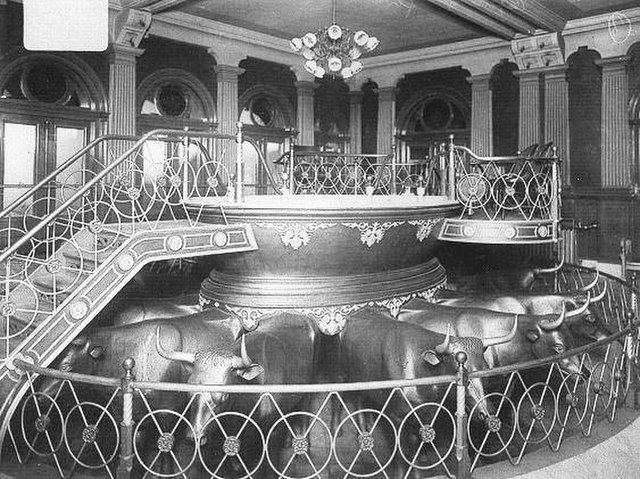The Molten Sea or Brazen Sea was a large basin in the Temple in Jerusalem made by Solomon for ablution of the priests. It is described in 1 Kings 7:23–26 and 2 Chronicles 4:2–5. It stood in the south-eastern corner of the inner court. According to the Bible it was five cubits high, ten cubits in diameter from brim to brim, and thirty cubits in circumference. The brim was like the rim of a cup or like a lily blossom, and its thickness was a hand breadth", three or four inches. It was placed on the backs of twelve oxen, standing with their faces outward. It was capable of containing two or three thousand baths of water. The fact that it was a wash basin which was too large to enter from above lends to the idea that water would likely have flowed from it down into a subcontainer beneath. The water was originally supplied by the Gibeonites, but was afterwards brought by a conduit from Solomon's Pools. The molten sea was made of brass or bronze, which Solomon had taken from the captured cities of Hadarezer, the king of Zobah. Ahaz later removed this laver from the oxen, and placed it on a stone pavement. It was destroyed by the Chaldeans.

An artist's rendition of the Molten Sea
The Brazen Sea is destroyed by the Chaldeans (watercolor, circa 1896–1902 by James Tissot, or followers)
Baptismal font in the Salt Lake Temple, circa 1912, where baptisms for the dead are performed.
Ritual washing in Judaism
In Judaism, ritual washing, or ablution, takes two main forms. Tevilah (טְבִילָה) is a full body immersion in a mikveh, and netilat yadayim is the washing of the hands with a cup.
A silver washing cup used for netilat yadayim
Ancient mikveh unearthed at Gamla
A Silver Mayim Acharonim Set
A medieval mikveh for the purpose of ritual immersion in Besalú, Spain







